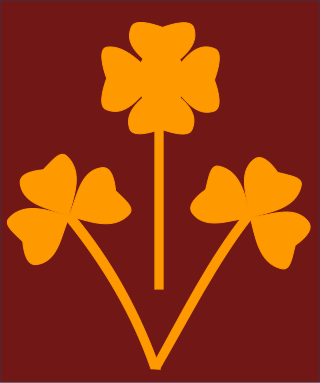
The 5th Indian Infantry Division was an infantry division of the Indian Army during World War II that fought in several theatres of war and was nicknamed the "Ball of Fire". It was one of the few Allied divisions to fight against three different armies - the Italian, German and Japanese armies.
The 23rd Indian Infantry Brigade was an infantry brigade formation of the Indian Army during World War II from 1941 to at least 1947. The brigade was formed in February 1941, at Loralai in India and in June 1941, assigned to the 14th Indian Infantry Division. In March 1942, the brigade was reassigned to the 23rd Indian Infantry Division, just before being renumbered 123rd Indian Infantry Brigade. As the 123rd the brigade served in the Burma Campaign with not only the 23rd but with the 14th again and the 5th Indian Infantry Division.

The 8th Mountain Division was raised as the 7th Indian Infantry division of the British Indian Army. It is now part of the Indian Army and specialises in mountain warfare.

The 10th Indian Infantry Division was a war formed infantry division of the Indian Army during World War II. In four years, the division travelled over 4,000 miles (6,400 km) from Tehran to Trieste, fought three small wars, and fought two great campaigns: the Anglo-Iraqi War, the Invasion of Syria–Lebanon, the Anglo-Soviet invasion of Iran, the North African Campaign, and the Italian Campaign.
The 2nd Indian Infantry Brigade was an infantry brigade formation of the Indian Army during World War II. It was formed in Rawalpindi in September 1939. In October 1940, it was renamed 16th (Independent) Indian Infantry Brigade in November 1941, and left India for Burma. The brigade was caught in the Battle of Sittang Bridge where it suffered heavy losses. Instead of being reformed in September 1942, it was renamed yet again, this time to 116th Indian Infantry Brigade. Attached to the 39th Indian Infantry Division it now provided specialised jungle conversion training. An infantry battalion would spend from four to six months with the brigade, before being sent to the front to replace a tired battalion in one of the fighting divisions.
The 3rd Indian Infantry Brigade was an Infantry formation of the Indian Army during World War II. It was formed at Jhelum in India in September 1939. In August 1943, it was renamed the Frontier Reserve Brigade
The 1st Indian Infantry Brigade was an infantry brigade formation of the Indian Army during World War II. It was formed in September 1939, in Abbottabad in India. It was assigned to HQ Rawalpindi District until May 1942, when it joined the 23rd Indian Infantry Division until the end of the war.

The 5th Indian Infantry Brigade was an infantry brigade formation of the Indian Army during World War II. It was converted from the 9th Indian Infantry Brigade in September 1939, and assigned to the 4th Indian Infantry Division. The brigade first moved to Egypt and took part in the early battles in North Africa. Then in 1941, it moved to the Sudan with the 5th Indian Infantry Division. Returning to 4th Indian Division command it took part in the Syria-Lebanon Campaign. The brigade then returned to North Africa coming under command of the 5th and 10th Indian Infantry Divisions, and the 50th (Northumbrian) Infantry Division and the 51st (Highland) Infantry Division in the Campaign in Tunisia. The brigade once more returned to the 4th Division for the Italian Campaign and the Greek Civil War.
The 11th Indian Infantry Brigade was an infantry brigade formation of the Indian Army during World War II. It was relocated from India to Egypt in the middle of August 1939 and trained at Fayed in Ismailia Governorate on the Great Bitter Lake. In October 1939, it was assigned to the 4th Indian Infantry Division. In May 1942, it was attached to the 5th Indian Infantry Division and in June the 2nd South African Infantry Division when it surrendered after Tobruk was captured by the Germans and Italians in 1942. The brigade was then reformed in Egypt in October 1943 and once more assigned to the 4th Indian Division serving in Tunisia, Italy and, at the end of the war, in Greece.
The 9th Indian Infantry Brigade was an infantry brigade formation of the Indian Army during World War II. Before the war the 9th (Jhansi) Infantry Brigade was a peacetime formation in Meerut district. This brigade was redesignated the 5th Indian Infantry Brigade and a new 9th Brigade was then formed all in September 1939. The new brigade was assigned to the 5th Indian Infantry Division in June 1940 to January 1944. It then spent February attached to the 7th Indian Infantry Division before returning to the 5th Division. The brigade spent two other short periods away from the 5th Division it was attached to the 17th Indian Infantry Division between March and April 1945 and was with the 19th Indian Infantry Division in April 1945, and returned to the 5th for the rest of the war.
The 48th Infantry Brigade, was raised as the 48 Indian Infantry Brigade, in October 1941, at Secunderabad, India. After an initial tenure with 19th Indian Infantry Division, it was transferred to the 17th Indian Infantry Division. In World War II it participated in the Burma campaign and in April 1942 was attached to 1st Burma Division. After the war the brigade returned to India as an independent brigade, and was located at Dhond in August 1947. After India gained Independence in 1947, 48 Indian Infantry Brigade was re-designated as 48 Infantry Brigade. Since then 48 infantry brigade has seen action Goa in 1961, as part of 17 Infantry Division; in the 1962 War in Kameng Frontier Division, Arunachal Pradesh, as part of 4th Infantry Division; and in the 1971 war, as part of 7th Infantry Division. Since the 1970s, 48 Infantry Brigade has been located in Ferozpur, Punjab, as part of 7 Infantry Division.
The 161st Indian Infantry Brigade was an infantry brigade formation of the Indian Army during World War II. As part of the arrangements for the independence and partition of British India the brigade was allocated to India and became the 161st Infantry Brigade in the army of the newly independent India.
The 10th Indian Infantry Brigade was an infantry brigade formation of the Indian Army during World War II. It was formed in September 1939. In June 1940 it was assigned to the 5th Indian Infantry Division and in September 1940, sailed for East Africa. The brigade spent time attached to other formations, the 4th Indian Infantry Division between June 1940 and March 1941, and the British 10th Armoured Division between March and June 1942, where it was destroyed during the Battle of Gazala. A new brigade was formed in Egypt and assigned to the 10th Indian Infantry Division, with which it fought in the Italian Campaign from April 1944 until the end of the war.
The 20th Indian Infantry Brigade was an infantry brigade formation of the Indian Army during World War II.
The 21st Indian Infantry Brigade was an infantry brigade formation of the Indian Army during World War II.
The 25th Indian Infantry Brigade was an infantry brigade formation of the Indian Army during World War II. It was formed in February, 1941 at Ahmednagar in India and assigned to the 10th Indian Infantry Division. The brigade was attached to the 8th Indian Infantry Division in August 1941, and took part in the Anglo-Soviet invasion of Iran. Returning to the 10th Indian Division in August 1941, they arrived in the desert just in time for the Battle of Gazala and continued to fight in the Western Desert Campaign and later in the Italian Campaign. While in Italy the brigade was attached to the British 46th Infantry Division from 7 to 11 December 1944.
The 14th Indian Infantry Brigade was an infantry brigade formation of the Indian Army during World War II. The brigade was formed at Attock, now in Pakistan, in October 1940, and assigned to the 7th Indian Infantry Division. In April 1942, the brigade was renumbered as the 114th Indian Infantry Brigade. The brigade fought in the Burma Campaign with the 7th Indian Division and later the 26th Indian Infantry Division.
The Landi Kotal Brigade was an infantry formation of the Indian Army during World War II. It was formed in 1920, for service on the North West Frontier. It was normal practice for newly formed battalions to be posted to the North West Frontier for service before being sent to Africa, Burma or Italy.
The Nowshera Brigade was an infantry brigade formation of the Indian Army during World War II. It was formed in September 1939, for service on the North West Frontier. It was normal practice for newly formed battalions to be posted to the North West Frontier for service before being sent to Africa, Burma or Italy.



